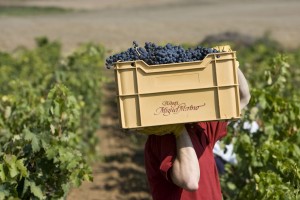 I first met Miguel Merino back in the ‘80s when we both had more hair and I was buying Rioja for Grants of St James’s. Miguel left Bodegas Berberana to develop Navarra wines just north of the River Ebro where his force of personality was instrumental in putting Navarran wines on the international wine map. Now he has realised his dream of owning his own Bodega and producing his own wines – fewer than 40,000 bottles a year making him one of the very smallest Bodegas in Rioja.
I first met Miguel Merino back in the ‘80s when we both had more hair and I was buying Rioja for Grants of St James’s. Miguel left Bodegas Berberana to develop Navarra wines just north of the River Ebro where his force of personality was instrumental in putting Navarran wines on the international wine map. Now he has realised his dream of owning his own Bodega and producing his own wines – fewer than 40,000 bottles a year making him one of the very smallest Bodegas in Rioja.
We have kept in touch regularly over the years and there is no more genuine, honest, fun-loving, smiling, hard-working person you could wish to meet and I urge you to visit his Bodega if you can. It is a pleasure to be able to offer his wines through our website
Rioja
Think Spain, think Rioja. What makes Rioja so special? A Bodega was traditionally a place where wine was aged, stored and only released when it was ready to drink, rather than ready to sell. So we drank the wines soft, smooth and already aged. Nowadays many are released earlier so we have to age them ourselves (cash flow, eh?!)
For centuries American oak was the wood of choice for the barrels but now some French oak is creeping in, as is a hint of Hungarian oak.
Tempranillo is the noble grape variety and the best-known indigenous Spanish grape. It’s usually blended with Garnacha (french Grenache), as well as much smaller proportions of Mazuelo (french Carignan) and Graciano.
To know your way round a Rioja label here is a summary of what to look for on the back label to see what you are getting;
- Crianza – may not be released to market before the 3rd year after the harvest. i.e. vintage 2008 may be released on 1stNovember 2010. Of those 24 months, at least 12 must have been in oak barrels.
- Reserva – may not be released to market before the 4th year after the harvest. i.e. vintage 2009 may be released on 1stNovember 2012. Of those 36 months, at least 12 must have been in oak barrels.
- Gran Reserva – may not be released to market before the 6th year after the harvest. i.e. vintage 2007 may be released on 1stNovember 2012. Of those 60 months, at least 24 must have been in oak barrels and 36 in bottle.
- Nothing mentioned at all (“Sin Crianza”) – here is usually a younger wine which has undergone either no barrel ageing or less than the 12 months minimum required for Crianza. You can’t tell from the label if it has had any oak ageing or not, so you need to ask your supplier
- CVC – “Conjunto Varios Cosechas” means it is a blend of different vintages and may be any style depending on what the producer wants to do, so no help unless you know the wine already, or ask the supplier.

